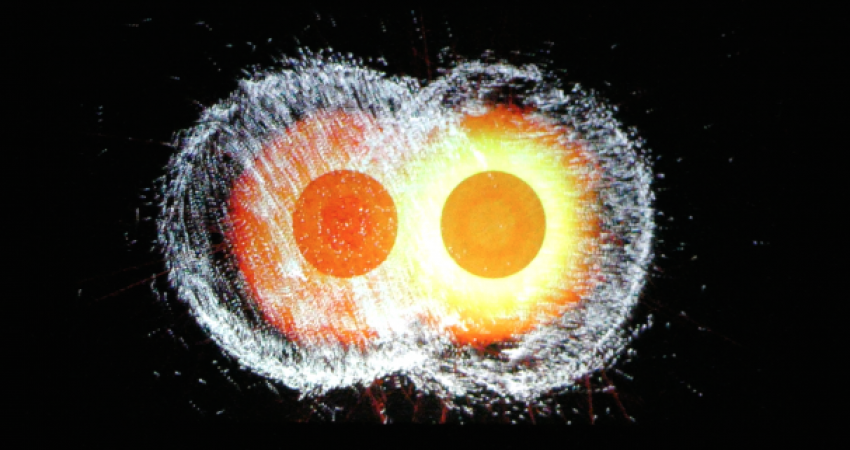Matters-ton

“Matters-ton” from Hyper Serial Music for Sound/Visual Performance
Sound Visual performance Matters-ton is a 2nd chapter of his Hyper Serial Music peroject/series aiming to expand, in new contemporary sense, classical means related to the history of Serial Music. In this work, Tatsuru developed and evolved into more complex and higher quality result, unfolding the relation between Sound and Matters on the three Dimensions of Space. By means of algorithmic simulation, principles designing the audiovisual substance are correlated directly on showing the physical side of Universe through human perception.
What is Hyper Serial Music?
Hyper serial music is extended classical contemporary music „12-ton and Serial music“ of Schönberg,Boulez,that innovated old basic music Algorythm to new music Structure with current technology,12 (playback speed) x12 (density) x12 (playback position),as Serialism, 1728 tones are evenly used.I will generate high-complex Glicth-noise,This time of this time composes for Audio Visual Live perfromance,the visual will be geometric 3D Architecht that could analyses real time on Sound(Hyper Serial).The traditional Serial music began from 12-tone technique of Schönberg in about 100 years ago. It has been evolved to the Serialism, by René Leibowitz and Pierre Boulez. In the history of music technology, Hyper-Serial-Music will add innovation to the principle of Serialism three-point: "structural", "complex" and "noisy". Hyper-Serial-Music is the algorithm music generated by state-of-the-art technology such as Artifcial Intelligence than by native human intelligence only.In summary, I believe that the innovation of core technique in the 600 years of music history is the process of making the structure of the music more complex. For example, Monophony of Middle Age turned into Polyphony, and Polyphony is completed into Tonality, and fnally Tonality collapsed into Atonal, 12-tone, Serial, New Complexity and Noise. 12-tone technique and Serial technique appeared in the works of Schönberg in early 20th century and was inherited by Anton von Webern and Alban Berg, it was further enhanced by as Olivier Messiaen, Boulez and Stockhausen. I believe 12-tone and Serialism are the most prominent technique in 20th-century art music history. I believe that 12-tone technique and Serialism have the strongest "geometric structure" of non random sound which do not use the same sound in a single cycle. 12-tone and Serialism are now old fashion technique. I fnd historical meaning to innovate 12-tone and Serialism by new technologies and new perspectives after 70 years of their birth. To innovate on Serialism regarding to the three-point of "structural", "complex" and "noisy", we have to create the artistic composing technique of computer algorithm, generated by Artifcial Intelligence. Hyper-Serial-Music will be exactly this innovation.
Structural Feature
Traditional 12-tone technique and Serialism is composed by the musical sound of 12 tones. On the other hand Hyper-Serial-Music is composed by the musical sound of 1728 tones generated by the algorithm of computer. This 1728-tone technique is constructed of three vectors,12 (playback speed) x12 (density) x12 (playback position). In the same way as Serialism, 1728 tones are evenly used. Noise Feature
Traditional musical instruments could produce only sound of 40-5000Hz. Hyper-Serial-Music, by using a computer, become free from constraints of the conventional instrument, and could make sound below 40HZ or over 5000HZ including noise sound. By this thing, Hyper-Serial-Music can be composed by 1728 tones. Complexity With respect to “structural feature” and “noisy feature” mentioned above, let us say that one sound, a single melody with only one frequency is 1 point, and white noise, a melody of sounds equally distributed in all frequency is 100 points. Once “structural” and “noisy” of traditional Serialism is about 50 points, Hyper-Serial-Music can control the sound close to 100 points by the computer algorithm. Serialism alone is hard to wear contrast. Because of the extremely more complex sound, the contrast of Hyper-Serial-Music is small. But if it is practical in Trans- Ages-Music, it will wear more contrast mixed with other traditional sound. This Hyper-Serial-Music, along with the extension of the sound functions is one of the music techniques to realize the maximum of dramaturgy of Trans- Ages-Music.



 Medialab-Matadero Madrid
Medialab-Matadero Madrid